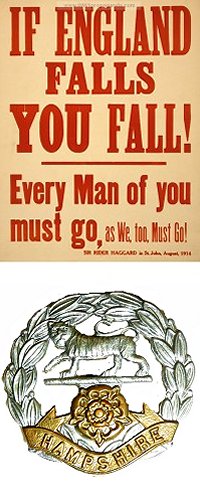yeovil at War
William Henry Sparks
Killed in day-to-day fighting
William Henry Sparks was born in Yeovil in 1888, the son of shop fitter Charles Sparks (b 1863), originally from Hemyock, Devon, and his Yeovil-born wife Catherine Bollen Batty née Hayward (b 1858). The nature of Charles' job meant that the family moved around and the 1891 census recorded them in Hammersmith, London. By the time of the 1901 census 13-year old William was living with his 84-year old grandmother Parthenia Hayward in Corfe Mullen, Dorset.
 William
enlisted in the
army at
Winchester, at
the age of 18 -
his Service
Number 7697
indicating that
he enlisted in
September 1906
in the 1st
(Regular)
Battalion of the
Hampshire
Regiment.
William
enlisted in the
army at
Winchester, at
the age of 18 -
his Service
Number 7697
indicating that
he enlisted in
September 1906
in the 1st
(Regular)
Battalion of the
Hampshire
Regiment.
In 1907 the Battalion were stationed in Londonderry, Northern Ireland, returning to Aldershot in 1910, transferring to Colchester, Essex, in 1913 which transferred them from the 2nd Division to the 4th Division. On 17 August the Special Reserve was at its coastal duties, the Territorials were also mobilized and were taking over their stations. This relieved the 4th Division from its temporary role as spearhead of the Home Defence Force duties. The 4th Division could now follow the rest of the British Expeditionary Force (BEF) overseas. On 21 - 22 August the 1st Battalion loaded on to their ships at Southampton the right wing on the Braemar Castle, the left wing along with the Rifle Brigade on the Cestrian, and headed for Le Havre, France. When the 1st Battalion arrived the BEF was already in contact with the Germans at Mons. The 1st Hampshire detrained at Le Cateau, and almost immediately entered a series of battles.
The Battle of Le Cateau was fought on 26 August 1914, after the British and French retreated from the Battle of Mons and had set up defensive positions in a fighting withdrawal against the German advance at Le Cateau. On the morning of 26 August, the Germans arrived and heavily attacked the British forces. Unlike the Battle of Mons, where the majority of casualties inflicted by the British were from rifle fire, Le Cateau was an artilleryman's battle, demonstrating the devastating results which modern quick-firing artillery using airbursting shrapnel shells could have on infantry advancing in the open. Holding their ground tenaciously against superior odds despite taking heavy casualties, by mid-afternoon, the right, then left flanks of the British, began to break under unrelenting pressure from the Germans. That night, the Allies withdrew to Saint-Quentin. Of the 40,000 British troops fighting at Le Cateau, 7,812 British casualties were incurred, including 2,600 taken prisoner.
The First Battle of the Marne, fought from 5 to 12 September 1914, resulted in an Allied victory against the German Army. The battle was the culmination of the German advance into France and pursuit of the Allied armies which followed the Battle of the Frontiers in August, which had reached the outskirts of Paris. The counterattack of six French field armies and the BEF along the Marne River forced the German Imperial Army to abandon its push on Paris and retreat north-east, leading to the 'Race to the Sea' and setting the stage for four years of trench warfare on the Western Front. The Battle of the Marne was an immense strategic victory for the Allies, wrecking Germany's bid for a swift victory over France and forcing it into a drawn-out two-front war.
The First Battle of the Aisne was the Allied follow-up offensive against the right wing of the German First and Second Armies as they retreated after the First Battle of the Marne earlier in September 1914. The offensive began on the evening of 13 September, after a hasty pursuit of the Germans. When the Germans turned to face the pursuing Allies on 13 September, they held one of the most formidable positions on the Western Front. Low crops in the unfenced countryside offered no natural concealment to the Allies but deep, narrow paths cut into the escarpment at right angles, exposing any infiltrators to extreme hazard. In dense fog on the night of 13 September, most of the BEF crossed the Aisne on pontoons or partially demolished bridges. Under the thick cover of the foggy night, the BEF advanced up the narrow paths to the plateau. When the mist evaporated under a bright morning sun, they were mercilessly raked by fire from the flank. Those caught in the valley without the fog's protective shroud fared no better. It soon became clear that neither side could budge the other and since neither chose to retreat, the impasse hardened into stalemate that would lock the antagonists into a relatively narrow strip for the next four years.
The Battle of Messines, fought between 12 October and 2 November 1914, was part of the 'Race to the Sea', the series of battles that decided the line of the Western Front. In the aftermath of the first Battle of the Marne, it was decided to move the BEF back north to Flanders, to shorten its supply lines back to the channel ports. The Battle of Messines was the official name for the fighting between the river Douve and the Comines-Ypres canal, but it merged into the battle of Armentières to the south and the first battle of Ypres to the north.
These were the last major engagements seen by the 1st Battalion Hampshire Regiment during 1914. Sadly, however, on 19 December 1914 William Sparks was killed during day-to-day fighting. He was 26 years old.
William Sparks is interred in Grave II.D.3, Lancashire Cottage Cemetery, Comines-Warneton, Belgium. His name was added to the War Memorial in the Borough in 2018.
gallery

The Commonwealth War Graves Commission certificate in memory of William Sparks.

William Sparks' headstone.